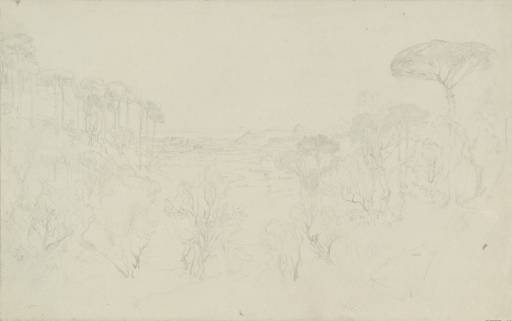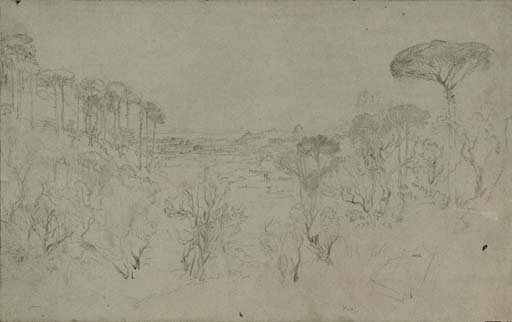Joseph Mallord William Turner Stone Pines on Monte Mario, with a View of Rome from near the Villa Mellini 1819
Image 1 of 2
Joseph Mallord William Turner,
Stone Pines on Monte Mario, with a View of Rome from near the Villa Mellini
1819
Joseph Mallord William Turner 1775–1851
Stone Pines on Monte Mario, with a View of Rome from near the Villa Mellini 1819
D16337
Turner Bequest CLXXXIX 11
Turner Bequest CLXXXIX 11
Pencil and grey watercolour wash on white wove ‘Valleyfield’ paper, 232 x 367 mm
Stamped in black ‘CLXXXIX 11’ bottom right
Stamped in black ‘CLXXXIX 11’ bottom right
Accepted by the nation as part of the Turner Bequest 1856
Exhibition history
1904
National Gallery, London, various dates to at least 1904 (263).
2008
¿¿¿¿¿¿ [Turner] (1775–1851), Pushkin Museum of Art, Moscow, November 2008–February 2009 (69, reproduced in colour).
2009
Turner from the Tate Collection, National Art Museum of China, Beijing, April–July 2009 (69, reproduced in colour).
References
1903
Charles Holme, Robert de la Sizeranne, Walter Shaw Sparrow and others, The Genius of J.M.W. Turner, R.A., London, Paris and New York 1903, reproduced p.25, pl.48, as ‘Rome: Stone Pines on Monte Mario’.
1904
E.T. Cook and Alexander Wedderburn (eds.), Library Edition: The Works of John Ruskin: Volume XIII: Turner: The Harbours of England; Catalogues and Notes, London 1904, no.263, pp.378, 622, as ‘Rome: Stone Pines on Monte Mario’.
1909
A.J. Finberg, A Complete Inventory of the Drawings of the Turner Bequest, London 1909, vol.I, p.562, as ‘Stone pines on Monte Mario. 263, N.G.’.
1920
D[ugald] S[utherland] MacColl, National Gallery, Millbank: Catalogue: Turner Collection, London 1920, p.87.
1925
Thomas Ashby, Turner’s Visions of Rome, London and New York 1925, p.22, reproduced pl.3 opposite p.8, as ‘Stone Pines on Monte Mario’.
2008
Anna Poznanskaya, Ian Warrell, Mathew Imms and others, ¿¿¿¿¿¿ [Turner], Pushkin Museum of Art, Moscow 2008, no.69, p.117, reproduced in colour, as ‘Stone Pines on Monte Mario’.
2009
Fan Di’an, Ian Warrell, Matthew Imms and others, Turner from the Tate Collection, exhibition catalogue, National Art Museum of China, Beijing 2009, no.69, pp.107, 177, reproduced in colour, p.110, as ‘Stone Pines on Monte Mario’.
Some of the most famous panoramas of Rome could be seen from the heights of Monte Mario, a hill to the north of the city. This pencil sketch, drawn over a grey watercolour wash, depicts the view looking south from a point beneath the Villa Mellini, a fifteenth-century residence built on the summit of the southern spur of Monte Mario for Cardinal Mario Mellini, after whom the hill is named. Today the building houses the Rome observatory and meteorological station but during the nineteenth century it was noteworthy as the location for one of the best panoramic views across the city. John Chetwode Eustace described the prospect in A Classical Tour in Italy:
One of the most conspicuous objects in the immediate neighbourhood of Rome is the Monte Mario ... a bold eminence lying about a mile north-west from the Porta-Angelica, clothed with vineyards and crowned with groves of cypress and poplar. On its summit rises the Villa Mellini, remarkable for the noble view that lies expanded under its terrace. The Tiber intersecting the city and winding through rich meadows; the Prata Quintia and Prata Mutia, fields still bearing their names, the trophies of Roman virtue and Roman heroism; the Pons Milvius with its tower, and the plains consecrated by the victory of Constantine; the Vatican Palace with its courts and gardens; the Basilica of St Peter with its portico, its obelisk, and its fountains, the Campus Martius covered with the churches, squares and palaces of the modern city; the seven hills strewed with ruins of the ancient; the walls with their towers and galleries; the desert Campagna, with Mount Soracte rising apparently in the centre; and the semi-circular sweep of mountains tinged with blue or purple, now bright with the sun, now dark in the shade, and generally gleaming with snow – such is the varied and magnificent scene spread out before the traveller, while reposing on the shaded terrace of Villa Mellini.1
The composition encompasses a sweep of approximately ninety degrees. Identifiable landmarks include, in the centre, the Castel Sant’Angelo and Ponte Sant’Angelo, with the Aventine Hill and Monte Testaccio above. To the right, is San Pietro in Montorio and the Janiculum Hill, and on the far right is the vast complex of St Peter’s and the Vatican. Thomas Ashby identified the straight thoroughfare in the central middle distance as the Viale Angelico, which runs through the meadows and gardens of the Prati di Castello to the Porta Angelica and the Vatican.2 In addition to a careful record of the topography the artist has also made detailed studies of the stone pine trees characteristic of the region. Turner recorded similar viewpoints on another sheet within this sketchbook (see Tate D16360; Turner Bequest CLXXXIX 33) and in the Small Roman C. Studies sketchbook (Tate D16481; Turner Bequest CXC 64). He also made several other images featuring alternative views from Monte Mario, see folios 31, 48, 57 and 60 (D16357, D16377, D16388, D16391) and loose sheets (D16342, D16350, D16352; CLXXXIX 16, 24, 26). Further studies can also be found within the St Peter’s sketchbook (see Tate D16174–D16181; Turner Bequest 9a–13).
As Cecilia Powell has discussed, the visual approach of depicting a distant prospect of the city from Monte Mario had a long artistic tradition.3 Turner may have known similar examples by his eighteenth-century landscape predecessors such as Richard Wilson’s Rome from the Villa Madama 1753 (Yale Center for British Art, New Haven),4 or John Robert Cozens’s Rome from the Villa Mellini circa 1783–8 (Fitzwilliam Museum, Cambridge).5 The large number of detailed studies devoted to the subject within this sketchbook suggests that Turner was seriously exploring the idea as a potential theme for a finished painting, and indeed this resulted in a watercolour, Rome, from the Monte Mario circa 1820–1 (private collection),6 one of a number of Italian scenes painted for Turner’s great friend and patron, Walter Fawkes, following the artist’s 1819 tour.
Verso:
Blank
Nicola Moorby
July 2009
How to cite
Nicola Moorby, ‘Stone Pines on Monte Mario, with a View of Rome from near the Villa Mellini 1819 by Joseph Mallord William Turner’, catalogue entry, July 2009, in David Blayney Brown (ed.), J.M.W. Turner: Sketchbooks, Drawings and Watercolours, Tate Research Publication, December 2012, https://www


